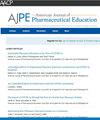Changes in Advanced Pharmacy Practice Experience Students’ Clinical Interventions Before, During, and After COVID-19
IF 3.5
4区 教育学
Q1 EDUCATION, SCIENTIFIC DISCIPLINES
引用次数: 0
Abstract
Objective
To describe the differences in advanced pharmacy practice experience (APPE) students’ clinical interventions, including the number of interventions, characterization, and acceptance, before, during, and after the COVID-19 pandemic.
Methods
Fourth-year student pharmacists for 3 faculty preceptors on inpatient internal medicine APPEs at a large, urban community medical center documented clinical interventions in an online database from May 2018 through April 2024. The database captured information related to the APPE block, preceptor, intervention category, intervention description, potential benefits, outcomes, and references. Data were extracted from the database for each APPE block and assigned into the following groupings: pre–COVID-19 (May 2018-March 2020), COVID-19 (May 2020-April 2022), and post–COVID-19 (May 2022-April 2024). Pre–COVID-19 and COVID-19 clinical interventions were compared to post–COVID-19.
Results
The pre–COVID-19 period included 59 students who documented 1752 interventions (mean 29.7 per student); the COVID-19 period had 62 students who documented 1402 interventions (mean 22.6 per student); and the post–COVID-19 period had 60 students who documented 1266 interventions (mean 21.1 per student). Compared to the post–COVID-19 period, pre–COVID-19 had significantly more interventions per student on average; however, the post–COVID-19 and COVID-19 periods were not significantly different.
Conclusion
Post–COVID-19 intervention numbers have not returned to pre–COVID-19 levels. Further qualitative analysis is warranted to explain this continued downtrend in student interventions.
新冠肺炎前、中、后高等药学实习生临床干预的变化
目的:了解新冠肺炎大流行前、期间和之后,高级药学实践经验(APPE)学生临床干预的差异,包括干预的数量、特征和接受程度。方法:2018年5月至2024年4月,一家大型城市社区医疗中心三名住院内科APPEs教师导师的四年级药学学生在在线数据库中记录了临床干预措施。该数据库捕获了与APPE块、受体、干预类别、干预描述、潜在益处、结果和参考文献有关的信息。从数据库中提取每个APPE区块的数据,并将其分为以下几组:COVID-19前(2018年5月- 2020年3月)、COVID-19(2020年5月- 2022年4月)和COVID-19后(2022年5月- 2024年4月)。将COVID-19前和COVID-19后的临床干预措施进行比较。结果:在covid -19之前,共有59名学生记录了1752项干预措施(平均每名学生29.7项);在COVID-19期间,有62名学生记录了1402项干预措施(平均每个学生22.6项);在covid -19后时期,有60名学生记录了1266项干预措施(平均每个学生21.1项)。与covid -19后相比,平均每个学生在covid -19前接受的干预措施明显更多;冠状病毒感染后与新冠病毒感染后无显著差异。结论:covid -19干预后的人数未恢复到covid -19前的水平。进一步的定性分析可以解释学生干预的持续下降趋势。
本文章由计算机程序翻译,如有差异,请以英文原文为准。
求助全文
约1分钟内获得全文
求助全文
来源期刊
CiteScore
4.30
自引率
15.20%
发文量
114
期刊介绍:
The Journal accepts unsolicited manuscripts that have not been published and are not under consideration for publication elsewhere. The Journal only considers material related to pharmaceutical education for publication. Authors must prepare manuscripts to conform to the Journal style (Author Instructions). All manuscripts are subject to peer review and approval by the editor prior to acceptance for publication. Reviewers are assigned by the editor with the advice of the editorial board as needed. Manuscripts are submitted and processed online (Submit a Manuscript) using Editorial Manager, an online manuscript tracking system that facilitates communication between the editorial office, editor, associate editors, reviewers, and authors.
After a manuscript is accepted, it is scheduled for publication in an upcoming issue of the Journal. All manuscripts are formatted and copyedited, and returned to the author for review and approval of the changes. Approximately 2 weeks prior to publication, the author receives an electronic proof of the article for final review and approval. Authors are not assessed page charges for publication.

 求助内容:
求助内容: 应助结果提醒方式:
应助结果提醒方式:


